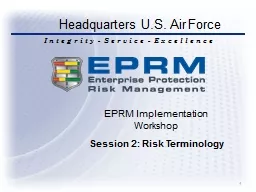PPT-I n t e g r i t y - S e r v i
Author : debby-jeon | Published Date : 2017-05-01
c e E x c e l l e n c e Headquarters US Air Force 1 EPRM Implementation Workshop Session 2 Risk Terminology Session Objectives 2 Learning Objective To be
Presentation Embed Code
Download Presentation
Download Presentation The PPT/PDF document "I n t e g r i t y - S e r v i" is the property of its rightful owner. Permission is granted to download and print the materials on this website for personal, non-commercial use only, and to display it on your personal computer provided you do not modify the materials and that you retain all copyright notices contained in the materials. By downloading content from our website, you accept the terms of this agreement.
I n t e g r i t y - S e r v i: Transcript
c e E x c e l l e n c e Headquarters US Air Force 1 EPRM Implementation Workshop Session 2 Risk Terminology Session Objectives 2 Learning Objective To be able to define the key terms associated with risk management as it pertains to the Air Force Security Enterprise.
Download Document
Here is the link to download the presentation.
"I n t e g r i t y - S e r v i"The content belongs to its owner. You may download and print it for personal use, without modification, and keep all copyright notices. By downloading, you agree to these terms.
Related Documents

